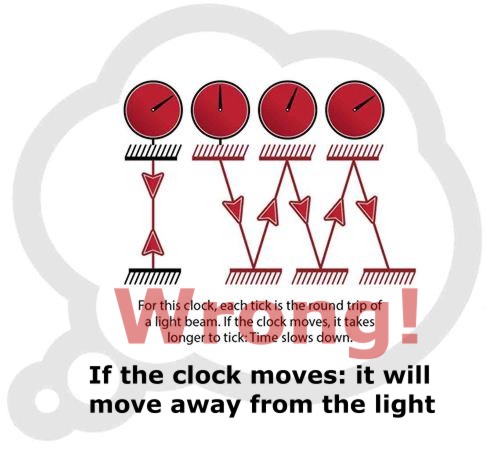~~~~~~~~~~~~~~~~~~~~~~
Einstein's Light Clock is a Blunder
~~~~~~~~~~~~~~~~~~~~~~
The light clock is wrong.
The moving apparatus (the clock) would just move away from the beam of light.
You would have to angle the light beam to make it hit the clock pads (mirrors) and that changes everything.
i.e. the distance the light beam has to travel does NOT increase because of the moving clock - it is because you have to angle the beam.
You might need to think about it for a couple of months to realize everything. Good luck with your endeavorers.
 "For this clock, each tick is the round trip of a light beam.
"For this clock, each tick is the round trip of a light beam.
If the clock moves, it takes longer to tick: Time slows down." -- Wrong
If you shine a beam of light at a target on the Moon - by the time the light reaches the Moon the target will have moved away from the path of the light.
Nothing dilated. Nothing happened to time.
The light beam is NOT going to automatically find the target.
The only way for the light beam to hit a steadily moving target is to angle the beam - and that of course is the only thing that lengthens the path.
REPEAT: Nothing dilated. Nothing happened to time.
 ~~~~~~~~~~~~~~~~~~~~~~~~~~~~~~~~~
~~~~~~~~~~~~~~~~~~~~~~~~~~~~~~~~~
Speed of light measured same for every observer?
~~~~~~~~~~~~~~~~~~~~~~~~~~~~~~~~~
Simple thought experiment blows-up relativity.
Walk with flashlight: speed of light is c + walk speed.
Reason: Time dilated (slowed) because you are walking?
So you measure light at c?
ok, now walk backwards: speed of light is c - walk speed.
Time dilates again and makes c measured even slower.
● Walk with flashlight:
light = c + walk speed - time dilation
measured speed = c
● Walk backwards with flashlight:
light = c - walk speed - time dilation
measured speed = c - ws - td
 ~~~~~~~~~~~~~~~~~~~~~
~~~~~~~~~~~~~~~~~~~~~
Einstein was correct by accident
~~~~~~~~~~~~~~~~~~~~~
Speed of light is always constant because light travels in a gravitationally-centered thread tension network (never been ruled out).
So, the speed of light is relative to the thread network surrounding the determining mass (moon, planet, star, system, galaxy, etc.)
The normal speed light |||||
traveling in the Andromeda galaxy (AG) is traveling at the speed of light.
So, all Andromedans would measure the speed of light to be c (that is the same for milky way).
But, Andromeda is racing >>>>> towards us.
So, if someone in Andromeda was shining a flashlight towards our Milky Way galaxy (MG) direction: the speed of light we measure should be speed of light c + Andromeda Galaxy speed.
The reason that does NOT happen is because: when light leaves the Andromeda galaxy it also leaves the Andromeda thread network and travels in the (for all intents and purposes) "stationary" universal thread network.
>>>(|AG|)>>> ||||||||| <<<(|MG|)<<<
Then when the light from Andromeda reaches the Milky Way, the speed conforms to the speed of light in the milky way.
No matter what happens elsewhere: the speed of light traveling through the milky way and reaching the earth will always be what we know as normal c
If you had a unbelievably high powered telescope and looked at the person shining the flashlight in Andromeda would you measure the speed of light as c + AGS? (Andromeda Galaxy Speed)
No, because you are in the milky way and all light has traveled all the way to you and that means it is traveling at milky way speed.
You would definitely see red shift or blue shift though.
 ~~~~~~~~~~~
~~~~~~~~~~~
Frame dragging?
~~~~~~~~~~~
Yes, and the stuff that is being dragged is the quantum thread network.
It is actually gravitationally-centered; that is stronger than frame dragging.
The fabric of space is a gravitationally-centered thread tension network
(never been ruled out)
Gravity is regular thread tension.
Tension = velocity squared x mass / Length
Vibrations traverse network at c
Plug in c, rearrange:
TL = mc^2
| -- inch -- |
Source of energy, gravity, all forces, light, you name it.
Thread length L and mass m are unchangeable constants.
Variable thread tension T will also vary the speed of light c.
Speed of time (as we know it) is also variable.
Speed of light is relative to thread network tension surrounding determining mass (planet, star, system, galaxy, etc.)
Tension = Force = Gravity
Higher gravity = higher tension = gamma rays
Higher tension will also increase the speed of light and all EMF's
But any fast light is converted and conforms to the milky way speed when it gets here - that was already explained
http://www.mccelt.com/emergence.php
Add a Comment
